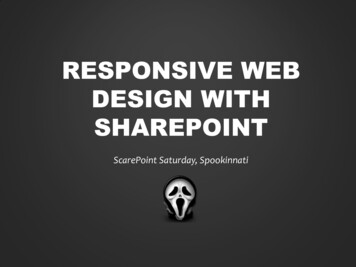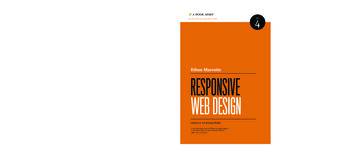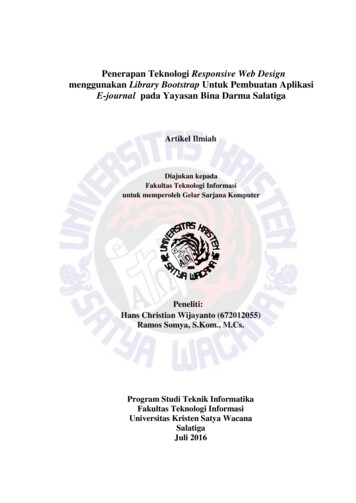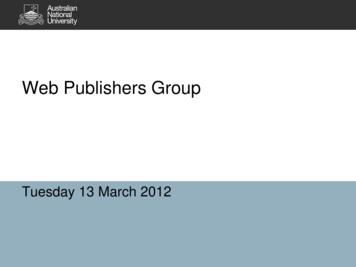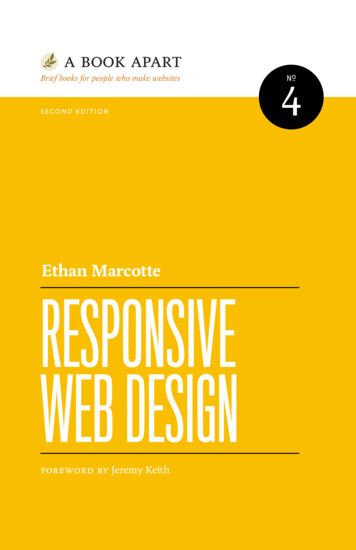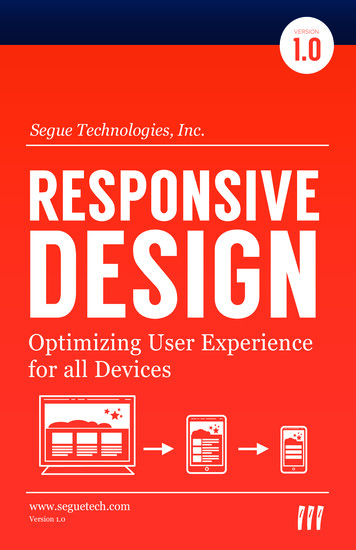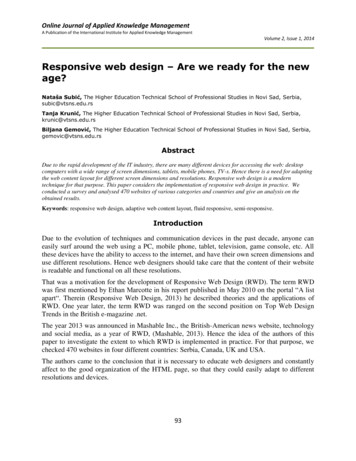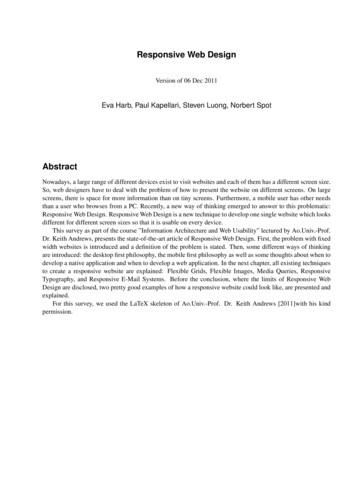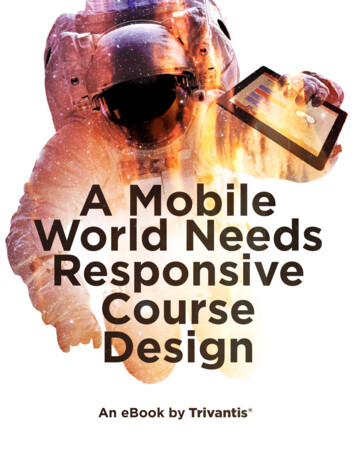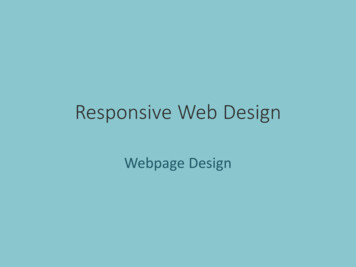
Transcription
Responsive Web DesignWebpage Design
Overview A short history of web design for mediaOne Web and Mobile FirstAdding flexibility to your layoutFlexible images?Media ow to design websites now
The evolution of web layoutsHTML4, Tables and FramesYears ago (mid 1990’s) it was common practice to let content flow to the margins of thebrowser window. Most screens weren’t high resolution, so lines of text rarely exceeded acomfortable length. Later (late 1990’s) as interface design became more complex (navigationcolumns!), tables or frames were used to divide and arrange the components of a page.Tables were used because there wasn’t much alternative and they were simple to code. InMarch 1996, Netscape Navigator introduced frames, a system where different page elementscould be marked up using different HTML files. This seemed like a good idea at the time.Frames were included as part of the HTML 3.0 specification by W3C.The Mosaic browser with free-flowing contentNetscape Navigator with content frames
Table-based layout html head title WEB PAGE TITLE GOES HERE /title /head For your amusement only, a typicaltable-based layout. Notice that allstyling is done in the markup – there’sno CSS. However, this layout is “flexible”. body style "margin: 0px; padding: 0px; font-family: 'Trebuchet MS',verdana;" table width "100%" style "height: 100%;" cellpadding "10" cellspacing "0" border "0" tr td colspan "2" style "height: 100px;" bgcolor "#777d6a" h1 Website Logo /h1 /td /tr tr td width "20%" valign "top" bgcolor "#999f8e" a href "#" Menu link /a br . a href "#" Menu link /a /td td width "80%" valign "top" bgcolor "#d2d8c7" h2 Page heading /h2 Here's a two column . br br The second table row . /td /tr /table /body /html HTML Table Layouts by Robert Darrell (2004)
XHTML: the new craze!XHTML and CSSIn January 2000, XHTML became a W3C recommendation. Although CSS1.0 was recommended back in December 1996, the first browser to fullysupport it (IE5 for Mac) wasn’t released until March 2000, by which time,CSS2 had been recommended. So it wasn’t until the early 21st Century thatall the tools were in place to enable webpage layouts to be implementedin the way we do now.Through the 2000’s, computermonitors changed from CRTs to LCDs,became bigger, changed aspect ratioand delivered higher resolutions.Whereas in the past, browsers (andtherefore websites) had been viewedfull-screen, they were now viewed inresized windows.
The fixed/flexible debateUser choice or designer control?A debate about how website layouts should be constructed followed. Some(mainly graphic designers) said that the designer should be in control of the layoutbecause they knew what looked/worked best and that layouts should be fixedwidth. Others took a more “user-centred” approach and argued that the usershould be able to choose what width they wanted the webpage to be and thatlayouts should be flexible (fluid or elastic).A hybrid fluid/fixed layout became a common solution for many websitesFixed vs. Fluid vs. Elastic Layout: What’s The Right One For You? Smashing Magazine (2009)
Complexity and divitisHow many nested divs!?Although the philosophical debate was won by those who advocated flexibledesign and user choice, it soon became clear that the available tools (XHTML andCSS) were just not up to the job of creating simple, flexible designs in all the manycombinations of columns required. In fact, the 3-column liquid layout becameknown as the “holy-grail” layout, because a good, simple solution was so difficultto achieve. During this same period, we saw the rise of the blog, with its distinctivemulti-column layout. Many designers took a pragmatic view and resorted to fixedwidth designs, making sure that they worked with most desktop/laptop monitors.The Perfect 3 Column Liquid Layout (Percentage widths) by Matthew James Taylor
Stylesheets for Media TypesYou want a different style for printers?Media Types have been part of the CSS toolkit sinceCSS2. There are a number of different media types,including: all, screen, print and handheld. Most welldesigned websites will at least have a printstylesheet that removes navigation links etc. link rel "stylesheet" type "text/css" media "screen" href "/style/default.css" / link rel "stylesheet" type "text/css" media "print" href "/style/print.css " /
The Mobile WebYou want to view websites on your phone!?Although the Handheld media type could be used to serve a different stylesheet tohandheld devices, few designers bothered because most mobile browsers weren’tparticularly capable. As browsers improved, developers decided to simply scale thedefault stylesheet because most sites didn’t have a handheld stylesheet. Manydesigners then decided it would be a good idea to provide an alternate mobileversion of their websites – the mobile web was born.bbc.co.uk/bbc.co.uk/mobile/
One WebW3C Mobile Web Best PracticesOne Web means making, as far as is reasonable, the same information andservices available to users irrespective of the device they are using.However, it does not mean that exactly the same information is availablein exactly the same representation across all devices.Opera says.One Web is the full, complete web that people access every day from theircomputers, their mobile devices, their home appliances, in their homes,offices and on the go — anytime, anywhere. With fundamentals, like webstandards, and technical innovations supporting widespread accessibility,people are able to access the same familiar web content seamlessly on anydevice.The “One Web” debate is still ongoing. Does it mean exactly the same content/services for alldevices/contexts or does it mean modified versions. What is agreed is that it doesn’t mean onewebsite for mobile users and another for desktop users.Mobile Web Best Practices 1.0 – W3C (2008)One Web: Unlimited Possibilities – Opera
Responsive Web DesignFlexible, Adaptive, Responsive – what does it all mean?Flexible web design means that a webpage can easily be viewed fullscreen or in a resized browser window on a desktop monitor becausewidths are defined as percentages. Adaptive design means that a webpagecan sense the screen width and configure itself accordingly, using fixedbreak-points*. Responsive design combines these 2 ideas, using flexibilitybetween break points.Responsive Web Design - .net Magazine* Other views exist.
Mobile FirstMobile is the true web experience?Some designers are now starting to wonder whether the desktop web isreally the richer experience. After all, a mobile phone can provide yourgeographic location, has a compass and accelerometer. Desktops can’t dothat. Maybe the mobile web experience is the richer of the two with manymore possibilities for interaction and real-time information gathering.Maybe websites should be designed for mobile devices first and thengracefully degrade for desktop devices?Aren’t Apps better?Of course, there is still another (different) debategoing on about whether content is better servedto mobile devices using an app or a webpage. Thiswhole debate is just about to get a lot morecomplicated as Windows 8 brings apps to thedesktop!Mobile First! - .net Magazine
It’s an exciting time to be aweb designer!
Making webpages responsiveEthan Marcotte – it’s all his fault.In May 2010, Ethan Marcotte wrote an article for A List Apart entitledResponsive Web Design.
What are the ingredients?Standing on the shoulders of giants.Marcotte was building on ideas first proposed in John Allsopp’s seminal article TheDao of Web Design (also for A List Apart), published in April 2000. In it, Allsoppsays:The control which designers know in the print medium, and often desire in the webmedium, is simply a function of the limitation of the printed page. We shouldembrace the fact that the web doesn’t have the same constraints, and design forthis flexibility. But first, we must “accept the ebb and flow of things.”Marcotte believes that now is the time to put these ideas into practice and it is allmade possible using CSS3 media queries, but that’s not the only ingerdient.Marcotte identifies 3:1.2.3.A flexible grid-based layout that uses relative sizingFlexible images and media, through dynamic resizing or CSSMedia queries and media query listenersResponsive Web Design by Katrien De Graeve
Flexible Gridstarget context resultWhen using percentages to specify the relative size ofelements on a web page, the percentage is always relative tothe parent element, or in this case, the context. The context isalways 1 (full-size), so if the result you are after is a columnwith a width of 192px set within a containing element with awidth of 960px, the formula gives us:192 960 0.2 (or 20%)However, in most cases, our result isn’t a nice round number.Let’s consider a more realistic scenario.
A Typical Blog566px331pxWhen working with grids, the number of pixels in eachcolumn is unlikely to be a nice, round number and theblog layout above could be described with the fixed pixelvalues given in the CSS on the right.#page {margin: 36px auto;width: 960px;}.blog {margin: 0 auto 53px;width: 900px;}.blog .main {float: left;width: 566px;}.blog .other {float: right;width: 331px;}
Pixels to Percentages566px331pxAlthough the calculated percentage values look a bitungainly, they work perfectly well – don’t be tempted toround the numbers up or down. Now, when the browserwindow is resized, the columns will also resizeproportionally.#page {margin: 36px auto;width: 90%;}.blog {margin: 0 auto 53px;width: 93.75%;}.blog .main {float: left;width: 62.8888889%;}.blog .other {float: right;width: 36.7777778%;}
Flexible ImagesYou want to display images smaller than they really are?To some extent, this technique goes against the grain. In order to conservebandwidth, images should only be displayed at their actual size. However,responsive design requires that we resize images to maintain the integrityof our layouts. div class "figure" p img src "robot.jpg" alt "" / b class "figcaption" Lo, the robot walks /b /p /div The markup, above* will be used to describe ourimage and a caption. Note that there are no width orheight attributes on the image element.*This markup is XHTML but you could use the HTML5 figure and figcaption elements.
Flexible ImagesThe CSSIn order to create a “fluid” image, we must apply the fluid bit (thepercentage) to a container. We must then use the max-width rule for theimage so that it remains inside its container and is therefore scaled with it.figure {float: right;margin-bottom: 0.5em;margin-left: 2.53164557%; /* 12px / 474px */width: 48.7341772%; /* 231px / 474px */}img {max-width: 100%;}Of course, things are never quite that simple – older browsersmay cause problems. See this article for more information.Fluid Images by Ethan Marcotte
Media QueriesThe magic ingredientCSS3 media queries are the magic ingredient that make responsive webdesign possible. A media query is a bit like a conditional statement. If thecondition is true, something changes, if not, nothing changes. In the caseof webpage layouts, we can make the condition the width of the screen inpixels and then apply a rule to change the default layout if it is true. Forexample, we could say, if the screen is less than 700px wide, the horizontalnavigation bar should be displayed vertically in a column. In this example,700px would be the “breakpoint” where the design changes.@media screen and (min-width: 1024px) {body {font-size: 100%;}}This media query says: if the media is ascreen and if that screen is 1024pxwide or more, set the font-size to100%. Elsewhere in our stylesheetthere may be a rule that says font-size:80% as a default value. Meaning that ifthe screen width is less than 1024px,text will display at 80%.
Up or Down?min-width or max-width?Notice that in the previous example, we used min-width to control whathappens when the screen gets wider than a certain number of pixels.However, we can also test for when the screen gets smaller by using maxwidth. For those scaling up from a Mobile First perspective, things willchange when the min-width breakpoint is found, whereas if you arescaling down from a desktop design, you will want to test using maxwidth.Which breakpoints should I use?Well that depends.Different devices will have set screen sizes (iPhone, iPad, Laptop, Desktopsee Chris Coyier’s Media Queries for Standard Devices), you could targetthose devices but what happens when they change and resolutionsincrease (as they inevitably will)? Some designers believe that mediaqueries should be content-focused rather than device specific. Anotherdebate.Responsive Design: Why You’re Doing It Wrong by Joshua Johnson
BreakpointsHow do we decide where the breakpoints should be?Breakpoints are where the design changes as the viewport gets larger orsmaller but should the design change for common viewport sizes (e.g.phone, tablet and desktop) or should it only change when appropriate forthe content?“While it’s tempting to choose breakpoints early inthe design process, perhaps based on the dimensionsof popular devices we know we need to support, thetruth is that we shouldn’t choose breakpoints at all.Instead, we should find them, using our content as aguide.”Scott Jehl – “Responsible Responsive Design”Some commentators have a more straightforward way of expressing this principle
“Start with the small screenfirst, then expand until itlooks like shit. TIME FOR ABREAKPOINT!”Stephen Hay
Dealing with IEIE 8 and lower do not understand media queriesIf (as we should) we take a “mobile first” approach to RWD, olderbrowsers that do not understand media queries will see only the “coreexperience” designed for mobile and not the progressively enhanceddesktop version of our designs. To overcome this problem, we can use aconditional comment to provide a fallback CSS file for versions of IE beforeversion 9 except mobile versions. !--[if (lt IE 9) & (!IEMobile)] link rel "stylesheet" href "ie.css" media "all" ![endif]--
Scaling on mobile devicesMobile device browsers assume that there is no responsive designBy default, mobile devices will scale all websites so that they fit on thedevice screen rather than obeying the media queries you have added tothe CSS. We have to tell mobile devices to display a webpage with a scaleof 1 in order for them to render our responsive designs as we intendedthem to be seen. We do this by adding a viewport meta tag to the head ofour webpage. meta name "viewport" content "width device-width, initial-scale 1"
Media Queries in ActionMedia Queries – example websites
Fixed/Fluid/Adaptive/Responsive?What’s the Difference Between Fixed, Fluid, Adaptive, and Responsive Web Design? by Treehouse
Fixed/Fluid/Adaptive/Responsive?ProportionalMedia QueriesFixed (static) Fluid (liquid) Adaptive Responsive What do all these terms mean?The table above gives the basic properties of the four common terms usedto describe how a webpage reacts to different window/screen sizes. Inmany cases, our goal is to create a responsive page that uses the mediaqueries of adaptive design and adds the proportionality of fluid designbetween break points.Liquidapsive.com (live example of these 4 concepts) by Nicholas Davison
Adaptive ResponsiveThere is a more subtle distinction We know that adaptive and responsive web design are not the same thingbecause although they both use media queries, adaptive sites do notchange between media query break points. However, there is also a moresubtle difference between the two concepts. Adaptive can be considereddevice specific with break points set for specific popular devices (e.g.iPhone, iPad, Desktop etc.). Responsive design attempts to createwebsites that work on all devices, even those that don’t yet exist. In orderto achieve this, an approach that has become known as “content-out”, isused.
Content-outOK, so now we look at the content first?The content-out or typography-first approaches to webpage design are, insome ways, a reaction against the over-reliance that some designers placeon grid systems and other non-content specific approaches to webpagelayout. The approach is logical because it focusses on the formation ofblocks of content rather than the page. In adaptive/responsive pages, thepage layout may change but blocks of content generally remain intact. Itmakes sense therefore to design content blocks first and then decide howthey will be arranged at different page widths.The typography-out approach in the world of browser-based web design by Elliot Jay Stocks
Web design – how?I thought I knew how to design a website – now I’m not sureMoodboards, grids, wireframes, photoshop comps and now movingcontent blocks and responsive pages – how the heck are we supposed todesign a website, there don’t appear to be any fixed points anymore? Thisis a mess. Should we be designing in the browser now?
FluxThe only thing we can depend on is that the web design process will bedifferent next week, next month and next yearAs designers, we need to experiment, find out what works best for us,share our ideas with others and listen to what others have to say abouttheir own approaches to design.
As an industry, we are still learningJason Santa Maria – listen to what this man saysAt the New Adventures in Web Design 2013 conference, Jason Santa Mariagave a talk entitled The Nimble Process in which he made a number ofconnected statements that hint at an approach to design The Nimble Process by Elliot Jay Stocks (video from the Smashing conference 2013)
“Early in the design process,details are your enemy.”Jason Santa Maria – “The Nimble Process”
“Start on paper – fuck fidelity– ideas want to be ugly.”Jason Santa Maria – “The Nimble Process”
“When possible, start withtext – the web is aboutcontent.”Jason Santa Maria – “The Nimble Process”
“Moodboards are dangerous– they focus not on what youwant to say but how you wantto say it.”Jason Santa Maria – “The Nimble Process”
“Grids are a bad thing to startwith.”Jason Santa Maria – “The Nimble Process”
“Use the right tool at theright time – designers need tobe flexible.”Jason Santa Maria – “The Nimble Process”
“There is no one single pathbut a pattern of possibilities;trial and error is good.”Jason Santa Maria – “The Nimble Process”
SummarySo, just run that by me again – how do Idesign websites?All you need in order to createcompetent web designs is a deepunderstanding of HTML and CSS, youmust buy into the principles of OneWeb, Content-out, Mobile First andResponsive Design and get to grips withthe use of media queries. Of course,there are many other considerations;content strategy, informationarchitecture, search engineoptimisation, accessibility and a littlescripting in JavaScript and PHP willhelp. Oh, and familiarity with one ormore content management systems is agood idea
“I know it feels like there is aninfinite amount of stuff tokeep up with every single day,but you know what? It’s okay.It’s okay not to knoweverything.”Jeremy Keith – The Mobile Book (forward)
Ethan Marcotte – it’s all his fault. In May 2010, Ethan Marcotte wrote an article for A List Apart entitled Responsive Web Design. . Responsive Web Design by Katrien De Graeve . Flexible Grids . target context result
